Thermal Performance of Finned Heat Sinks Embedded with Form-Stable Myristic Acid Phase Change Material in Photovoltaic Cooling for Green Energy Storage
Abstract
:1. Introduction
2. Materials and Methods
2.1. Fin Heat Sink Configuration and Location of Thermocouples
2.2. Experimental Setup for Preliminary Performance Assessment on FHS and FHS-FSPCM
2.3. Experimental Setup for Application of FHS-FSPCM on Photovoltaic (PV) Panel
3. Results and Discussion
3.1. Preliminary Thermal Performance Assessment of FHS and FHS-FSPCM with Different Power Supply
3.2. Application of FHS-FSPCM on Photovoltaic Panel
4. Conclusions
Author Contributions
Funding
Data Availability Statement
Acknowledgments
Conflicts of Interest
References
- Kafka, J.; Miller, M.A. A Climatology of Solar Irradiance and Its Controls across the United States: Implications for Solar Panel Orientation. Renew. Energy 2018, 125, 707–897. [Google Scholar] [CrossRef]
- Ali, H.M.; Mahmood, M.; Bashir, M.A.; Ali, M.; Siddiqui, A. Outdoor testing of photovoltaic modules during summer in Taxila, Pakistan. Therm. Sci. 2016, 20, 165–173. [Google Scholar] [CrossRef] [Green Version]
- Moh, T.S.Y.; Ting, T.W.; Lau, A.H.Y. ScienceDirect Graphene Nanoparticles (GNP) Nanofluids as Key Cooling Media on a Flat Solar Panel through Micro-Sized Channels. Energy Rep. 2020, 6, 282–286. [Google Scholar] [CrossRef]
- Almosni, S.; Delamarre, A.; Jehl, Z.; Suchet, D.; Giteau, M.; Behaghel, B.; Julian, A.; Tatry, L.; Wang, H.; Kubo, T.; et al. Material Challenges for Solar Cells in the Twenty- First Century: Directions in Emerging Technologies. Sci. Technol. Adv. Mater. 2018, 6996, 1–34. [Google Scholar] [CrossRef] [PubMed]
- Arifin, Z.; Tjahjana, D.D.D.P.; Hadi, S.; Rachmanto, R.A.; Setyohandoko, G.; Sutanto, B. Numerical and experimental investigation of air cooling for photovoltaic panels using aluminum heat sinks. Int. J. Photoenergy 2020, 2020, 1–9. [Google Scholar] [CrossRef]
- Popovici, C.G.; Hudişteanu, S.V.; Mateescu, T.D.; Cherecheş, N.C. Efficiency improvement of photovoltaic panels by using air cooled heat sinks. Energy Procedia 2016, 85, 425–432. [Google Scholar] [CrossRef] [Green Version]
- Fathi, M.; Abderrezek, M.; Djahli, F. Heating behavior of photovoltaic panels and front side water cooling efficiency. Appl. Sol. Energy 2019, 55, 327–339. [Google Scholar] [CrossRef]
- Irwan, Y.M.; Leow, W.Z.; Irwanto, M.; Amelia, A.R.; Gomesh, N.; Safwati, I. Indoor test performance of pv panel through water cooling method. Energy Procedia 2015, 79, 604–611. [Google Scholar] [CrossRef] [Green Version]
- Jaaz, A.H.; Hasan, H.A.; Sopian, K.; Kadhum, A.A.H.; Gaaz, T.S.; Al-Amiery, A.A. Outdoor performance analysis of a photovoltaic thermal (PVT) collector with jet impingement and compound parabolic concentrator (CPC). Materials 2017, 10, 888. [Google Scholar] [CrossRef] [Green Version]
- Markal, B.; Varol, R. The effect of jet impingement on the performance of a photovoltaic module. SETSCI Conf. Proc. 2019, 4, 647–650. [Google Scholar]
- Hasan, I.A.; Attar, D.A. Improved Photovoltaic Panel Performance Using a Cylindrical Pin Fins as a Heat Sink. Univ. Thi-Qar J. Eng. Sci. 2019, 10, 84–97. [Google Scholar]
- Kim, J.; Nam, Y. Study on the cooling effect of attached fins on PV using CFD simulation. Energies 2019, 12, 758. [Google Scholar] [CrossRef] [Green Version]
- Habeeb, L.J.; Mutasher, D.G.; Ali, F.A.M.A. Solar panel cooling and water heating with an economical model using thermosyphon. Jordan J. Mech. Ind. Eng. 2018, 12, 189–196. [Google Scholar]
- Habeeb, L.J.; Mutasher, D.G.; Ali, F.A.M.A. Cooling photovoltaic thermal solar panel by using heat pipe at Baghdad climate. Int. J. Mech. Mechatron. Eng. 2017, 17, 171–185. [Google Scholar]
- Hasan, A.; McCormack, S.J.; Huang, M.J.; Sarwar, J.; Norton, B. Increased photovoltaic performance through temperature regulation by phase change materials: Materials comparison in different climates. Sol. Energy 2015, 115, 264–276. [Google Scholar] [CrossRef]
- Baqi, S.A.; Hassan, A.; Shah, A.H. Performance Optimization of Concentrated Photovoltaic-Thermal (CPV-T) System Employing Phase Change Material (PCM) in Hot Climate. In Renewable Energy and Sustainable Buildings; Springer: Cham, Switzerland, 2020; pp. 579–594. [Google Scholar]
- Siecker, J.; Kusakana, K.; Numbi, B.P. A Review of Solar Photovoltaic Systems Cooling Technologies. Renew. Sustain. Energy Rev. 2017, 79, 192–203. [Google Scholar] [CrossRef]
- Zhao, J.; Yang, Y.; Li, Y.; Zhao, L.; Wang, H.; Song, G.; Tang, G. Microencapsulated phase change materials with TiO2-doped PMMA shell for thermal energy storage and UV-shielding. Sol. Energy Sol. Cells 2017, 168, 62–68. [Google Scholar] [CrossRef]
- Zilio, C.; Righetti, G.; Mancin, S.; Hodot, R.; Sarno, C.; Pomme, V.; Tru, B. Active and Passive Cooling Technologies for Thermal Management of Avionics in Helicopters: Loop Heat Pipes and Mini-Vapor Cycle System. Therm. Sci. Eng. Prog. 2018, 5, 107–116. [Google Scholar] [CrossRef]
- Wang, H.; Zhao, L.; Chen, L.; Song, G.; Tang, G. Facile and Low Energy Consumption Synthesis of Microencapsulated Phase Change Materials with Hybrid Shell for Thermal Energy Storage. J. Phys. Chem. Solids 2017, 111, 207–213. [Google Scholar] [CrossRef]
- Koukou, M.K.; Vrachopoulos, M.G.; Tachos, N.S. Experimental and Computational Investigation of a Latent Heat Energy Storage System with a Staggered Heat Exchanger for Various Phase Change Materials. Therm. Sci. Eng. Prog. 2018, 7, 87–98. [Google Scholar] [CrossRef]
- Bland, A.; Khzouz, M.; Statheros, T.; Gkanas, E.I. PCMs for Residential Building Applications: A Short Future Development. Buildings 2017, 7, 78. [Google Scholar] [CrossRef] [Green Version]
- Vasu, A.; Hagos, F.Y.; Noor, M.M.; Mamat, R.; Azmi, W.H.; Abdullah, A.; Ibrahim, T.K. Corrosion e Ff Ect of Phase Change Materials in Solar Thermal Energy Storage Application. Renew. Sustain. Energy Rev. 2017, 76, 19–33. [Google Scholar] [CrossRef] [Green Version]
- Fang, Y.; Wei, H.; Liang, X.; Wang, S.; Liu, X.; Gao, X.; Zhang, Z. Preparation and Thermal Performance of Silica/n-Tetradecane Microencapsulated Phase Change Material for Cold Energy Storage. Energy Fuels 2016, 30, 9652–9657. [Google Scholar] [CrossRef]
- Senthilkumar, M.; Balasubramanian, K.R.; Kottala, R.K.; Sivapirakasam, S.P.; Maheswari, L. Characterization of Form-Stable Phase-Change Material for Solar Photovoltaic Cooling. J. Therm. Anal. Calorim. 2020, 141, 2487–2496. [Google Scholar] [CrossRef]
- Tangsiriratana, E.; Skolpap, W.; Patterson, R.J.; Sriprapha, K. Thermal Properties and Behavior of Microencapsulated Sugarcane Wax Phase Change Material. Heliyon 2019, 5, e02184. [Google Scholar] [CrossRef] [Green Version]
- Wu, D.; Wen, W.; Chen, S.; Zhang, H. Preparation and Properties of a Novel Form-Stable Phase Change Material Based on a Gelator. J. Mater. Chem. A Mater. Energy Sustain. 2015, 3, 2589–2600. [Google Scholar] [CrossRef]
- Wong, J.L.O.; Munusamy, Y.; Ong, K.S. Effect of Sulfur Addition into Nitrile Rubber Latex on Coating Performance of Phase Change Material. AIP Conf. Proc. 2019, 2157, 020047. [Google Scholar] [CrossRef]
- Huang, X.; Guo, J.; He, J.; Gong, Y.; Wang, D.; Song, Z. Novel Phase Change Materials Based on Fatty Acid Eutectics and Triallyl Isocyanurate Composites for Thermal Energy Storage. J. Appl. Polym. Sci. 2017, 134, 1–8. [Google Scholar] [CrossRef]
- Yew, G.Y.; Tham, T.C.; Law, C.L.; Chu, D.; Ogino, C.; Show, P.L. Emerging Crosslinking Techniques for Glove Manufacturers with Improved Nitrile Glove Properties and Reduced Allergic Risks. Mater. Today Commun. 2019, 19, 39–50. [Google Scholar] [CrossRef]
- Cheng, Z.; Yan, M.; Cao, L.; Huang, J.; Cao, X.; Yuan, D.; Chen, Y. Design of Nitrile Rubber with High Strength and Recycling Ability Based on Fe 3+ − Catechol Group Coordination. Ind. Eng. Chem. Res. 2019, 58, 3912–3920. [Google Scholar] [CrossRef]
- Paul, D.I. Experimental Characterisation of Photovoltaic Modules with Cells Connected in Different Configurations to Address Nonuniform Illumination Effect. J. Renew. Energy 2019, 2, 1–15. [Google Scholar] [CrossRef]
- Beemkumar, N.; Karthikeyan, A.; Manoj, A.; Keerthan, J.S.; Stallan, J.P.; Amithkishore, P. Investigation of Sensible and Latent Heat Storage System Using Various HTF. IOP Conf. Ser. Mater. Sci. Eng. 2017, 197, 012038. [Google Scholar] [CrossRef] [Green Version]
- Reddy, K.S.; Mudgal, V.; Mallick, T.K. Review of Latent Heat Thermal Energy Storage for Improved Material Stability and Effective Load Management. J. Energy Storage 2018, 15, 205–227. [Google Scholar] [CrossRef]
- Zavrl, E.; Stritih, U. Improved thermal energy storage for nearly zero energy buildings with PCM integration. Sol. Energy 2019, 190, 420–426. [Google Scholar]
- Kiwan, S.; Ahmad, H.; Alkhalidi, A.; Wahib, W.O.; Al-Kouz, W. Photovoltaic Cooling Utilizing Phase Change Materials. In E3S Web of Conferences; EDP Sciences; ICRET 2020: Perth, Australia, 2020; Volume 160, p. 02004. [Google Scholar]
- Ghosal, J. Thermal Management of Photovoltaic Panel Using PCM for Improved Efficiency and Power Output. Ph.D. Thesis, University of Windsor, Windsor, ON, Canada, 2019; 197p. [Google Scholar]
- Ali, H.M. Recent advancements in PV cooling and efficiency enhancement integrating phase change materials based systems–A comprehensive review. Sol. Energy 2020, 197, 163–198. [Google Scholar] [CrossRef]
- Ciulla, G.; Lo Brano, V.; Franzitta, V.; Trapanese, M. Assessment of the operating temperature of crystalline PV modules based on real use conditions. Int. J. Photoenergy 2014, 2014, 1–11. [Google Scholar] [CrossRef] [Green Version]
- Osma-Pinto, G.; Ordóñez-Plata, G. Dynamic thermal modelling for the prediction of the operating temperature of a PV panel with an integrated cooling system. Renew. Energy 2020, 152, 1041–1054. [Google Scholar] [CrossRef]
- Smith, M.K.; Selbak, H.; Wamser, C.C.; Day, N.U.; Krieske, M.; Sailor, D.J.; Rosenstiel, T.N. Water cooling method to improve the performance of field-mounted, insulated, and concentrating photovoltaic modules. J. Sol. Energy Eng. 2014, 136, 034503. [Google Scholar] [CrossRef]
- Bayrak, F.; Oztop, H.F.; Selimefendigil, F. Experimental study for the application of different cooling techniques in photovoltaic (PV) panels. Energy Convers. Manag. 2020, 212, 112789. [Google Scholar] [CrossRef]
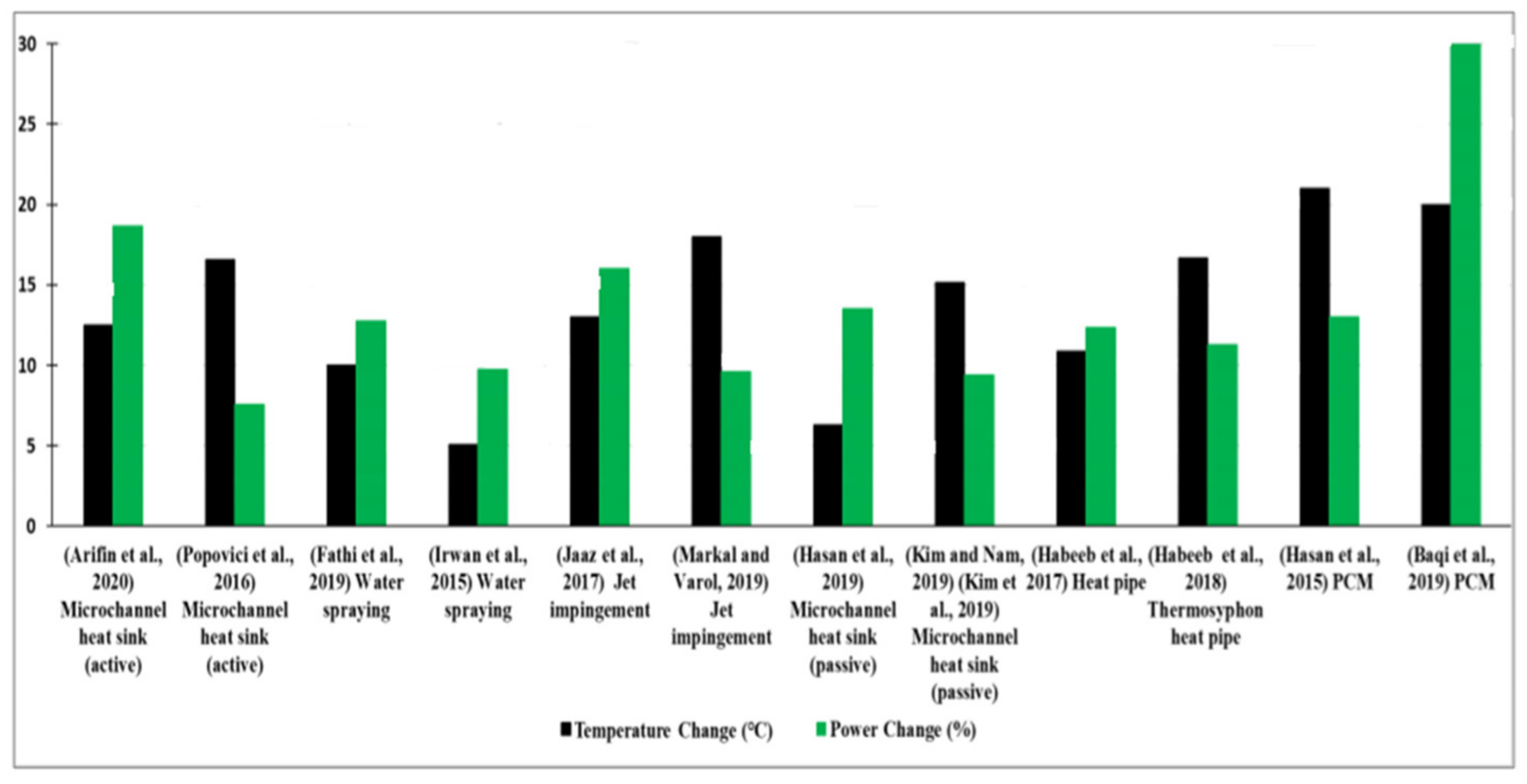
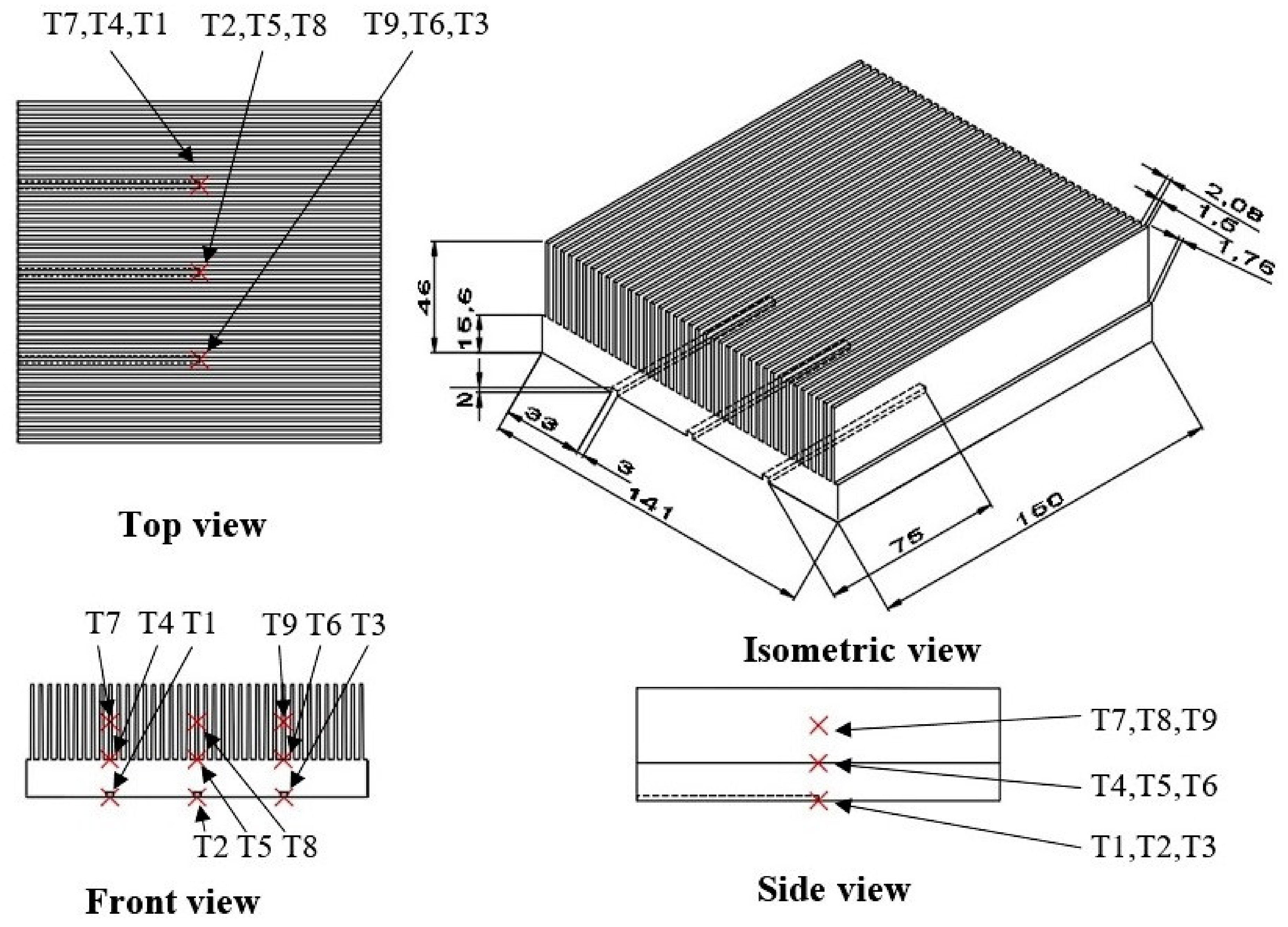
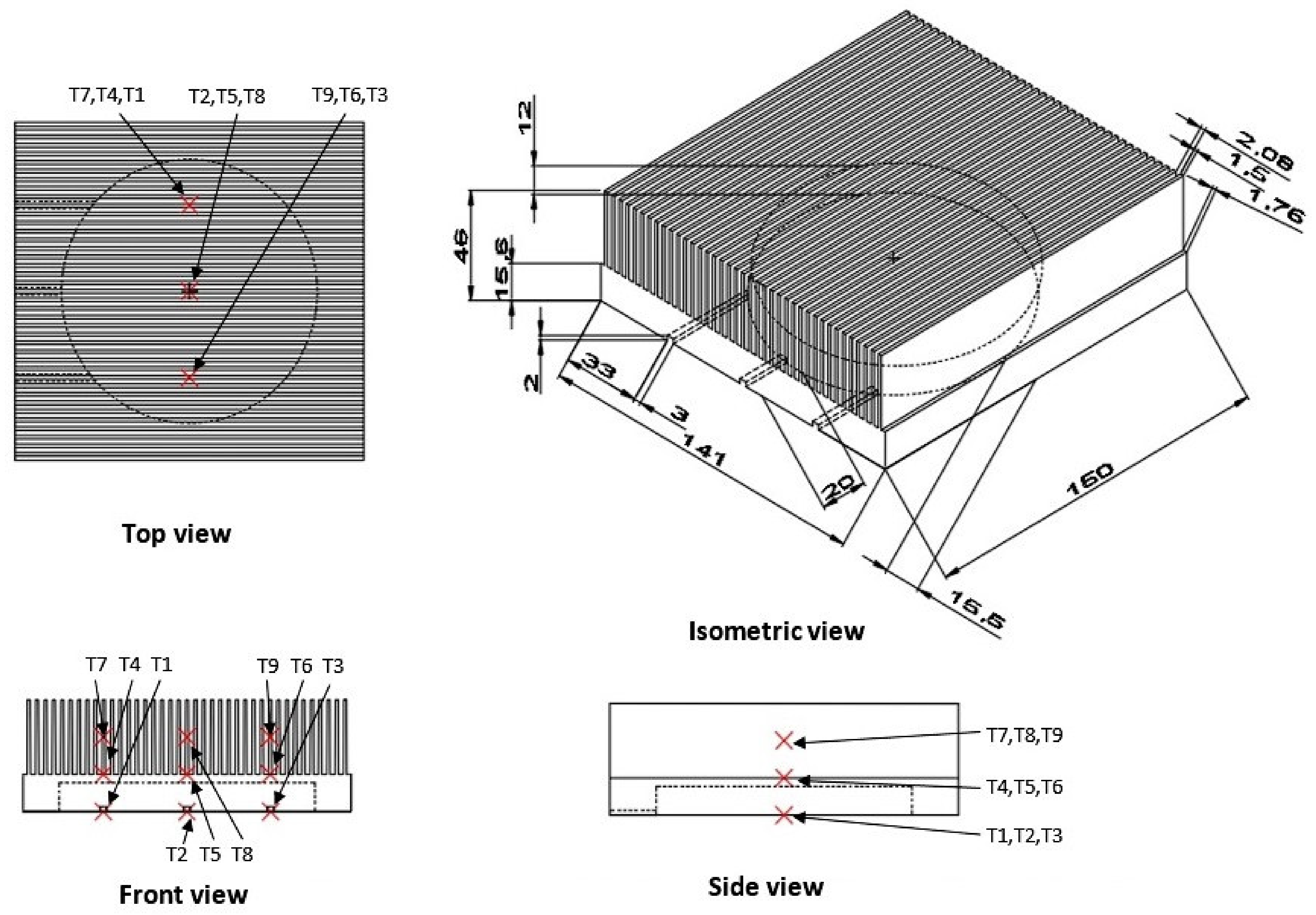
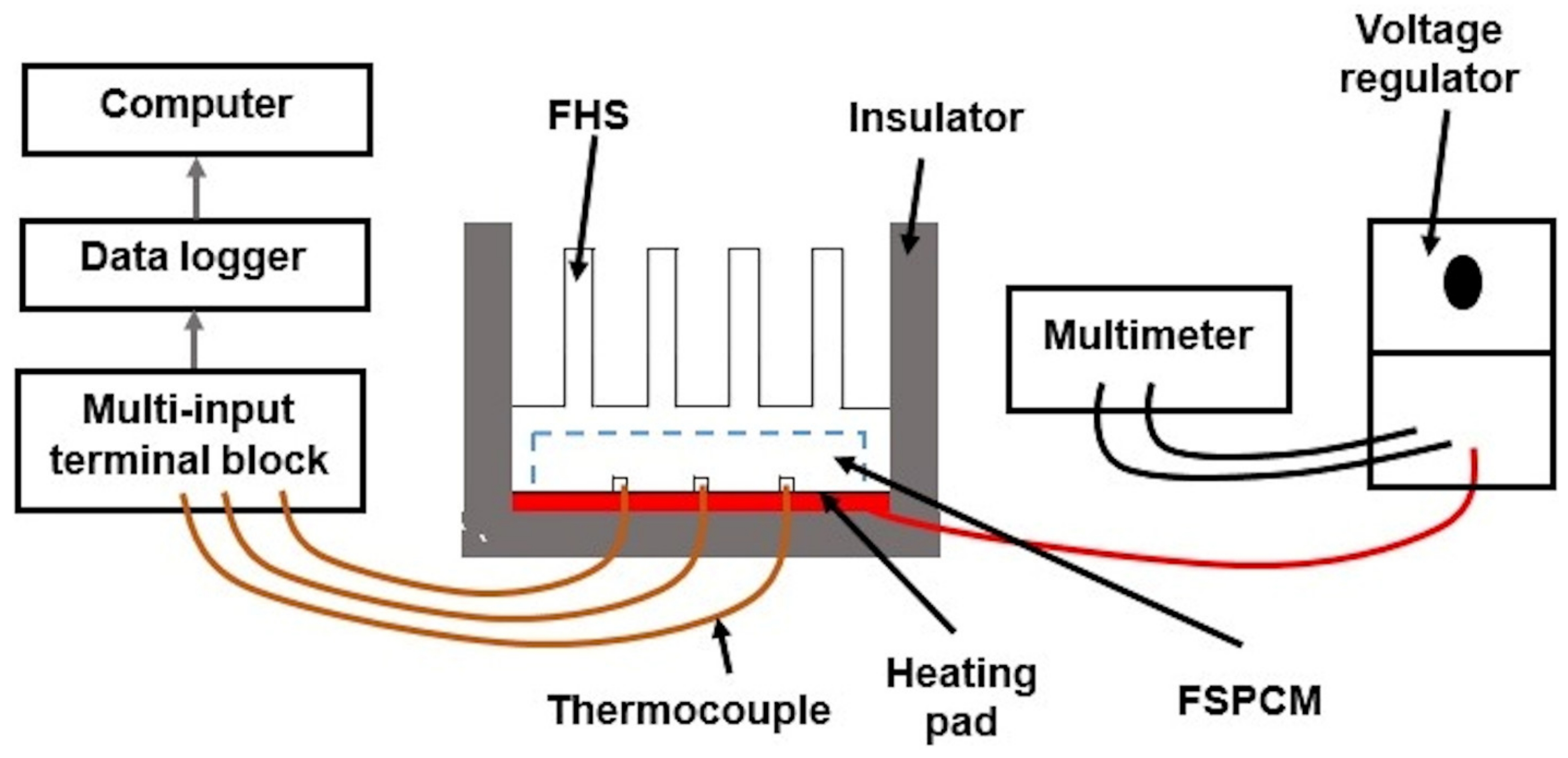
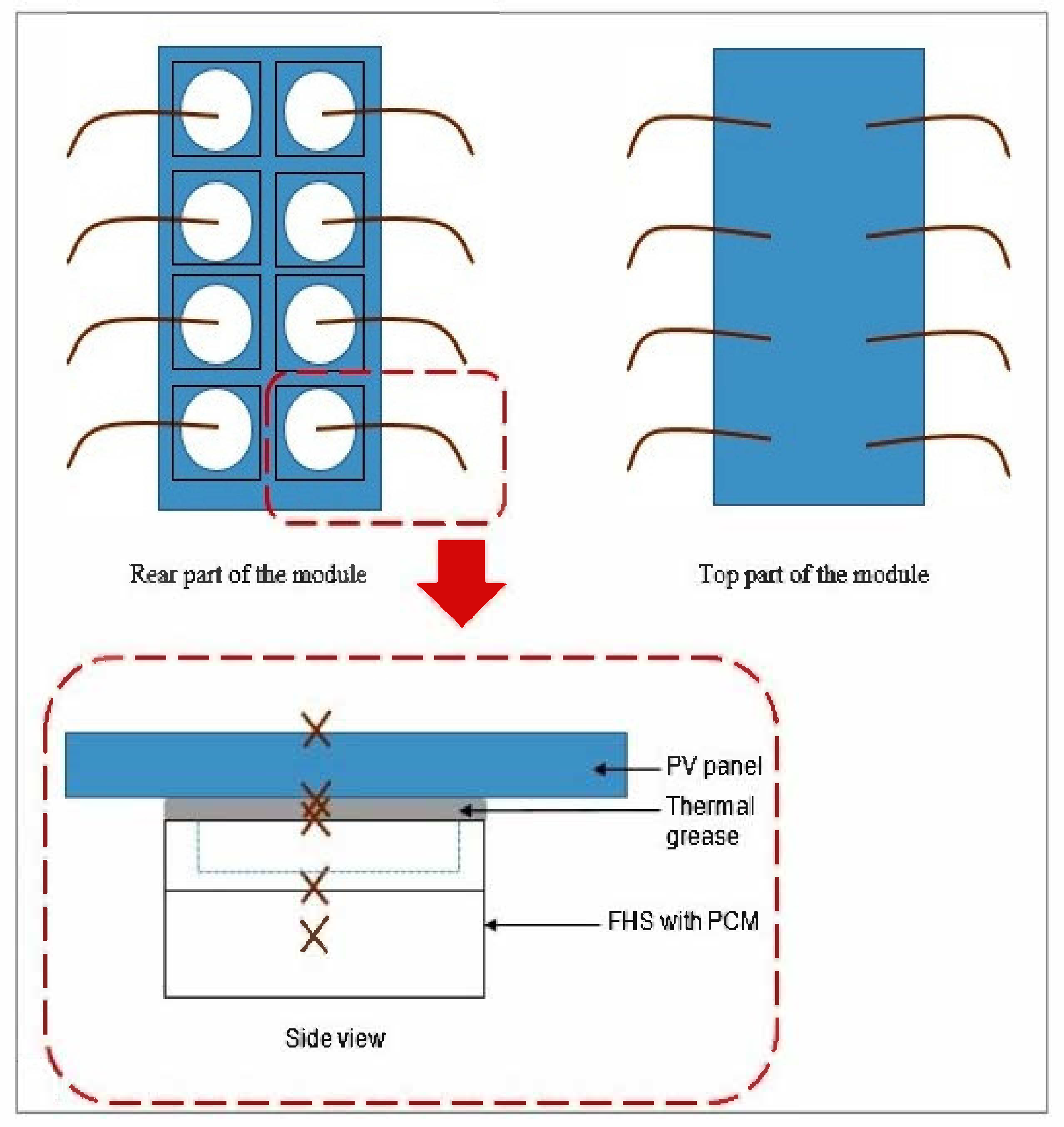
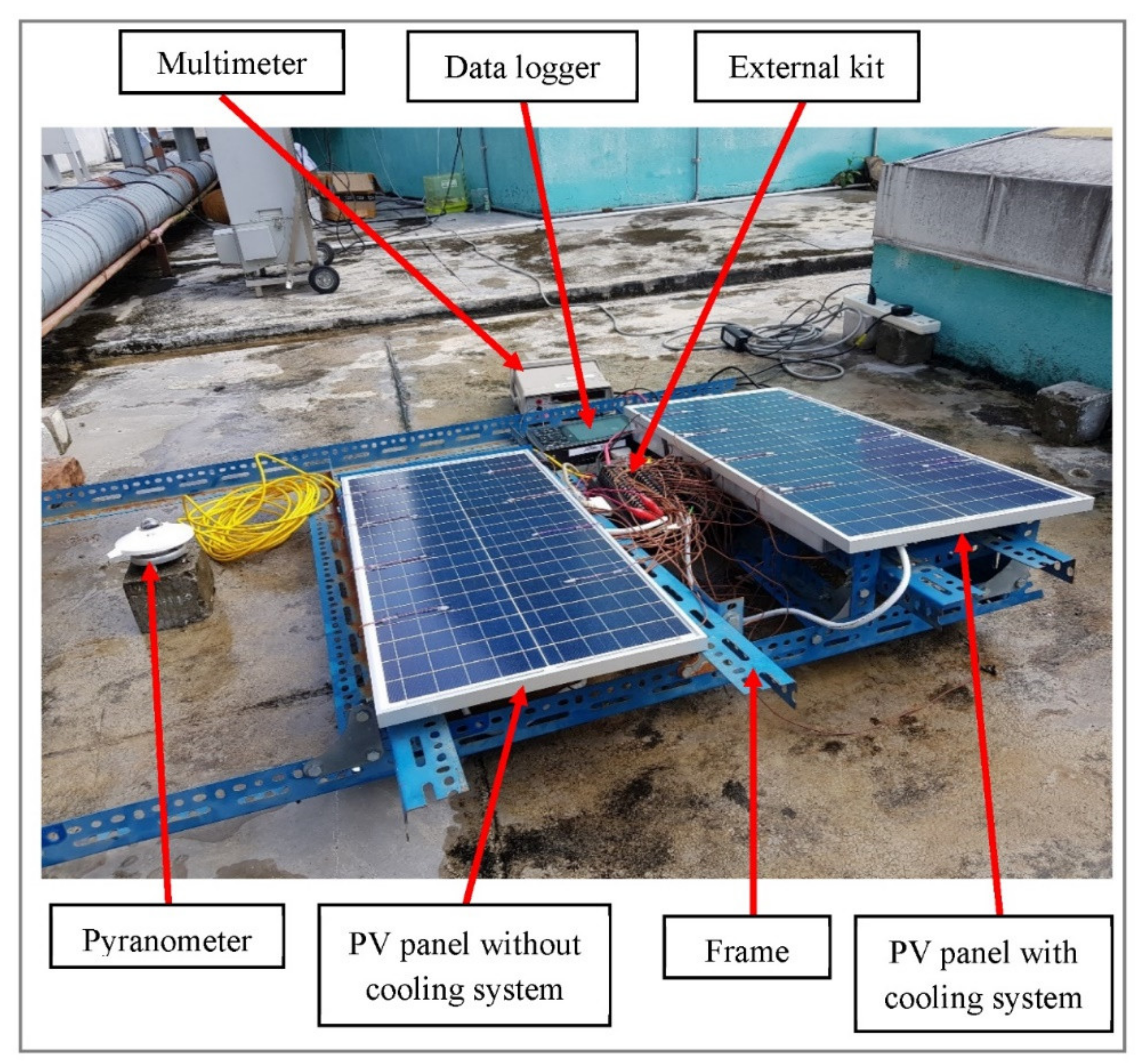
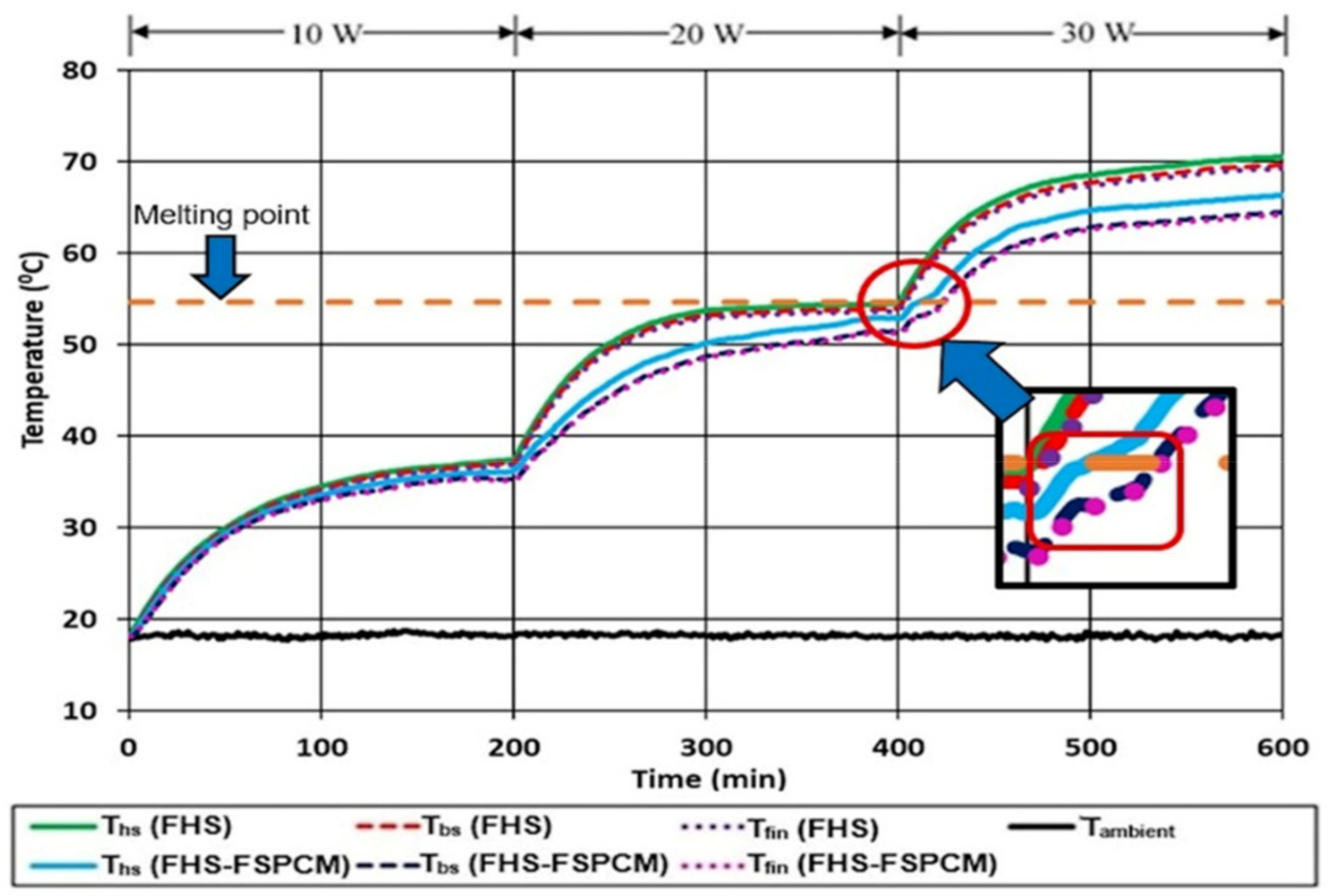
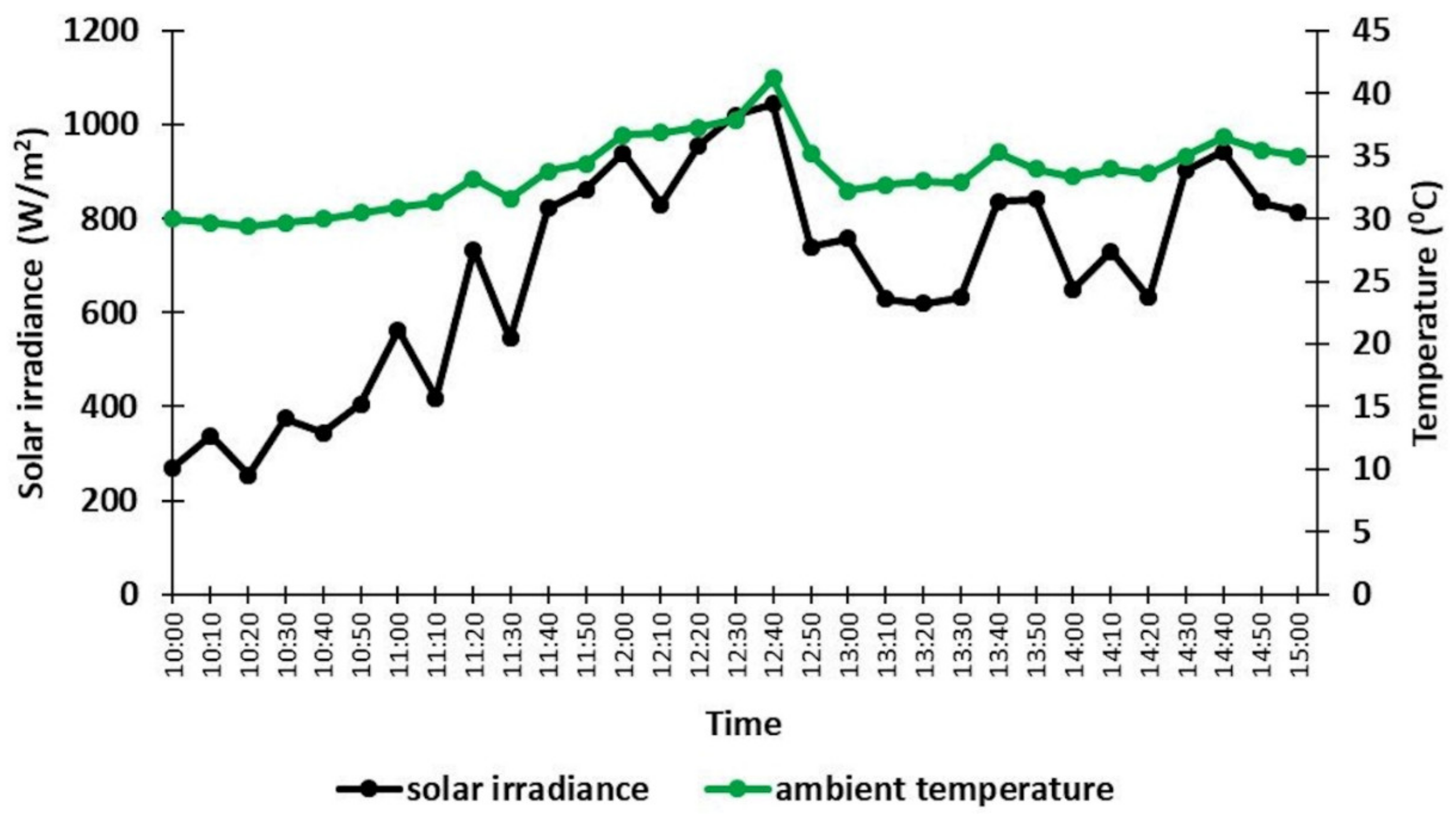
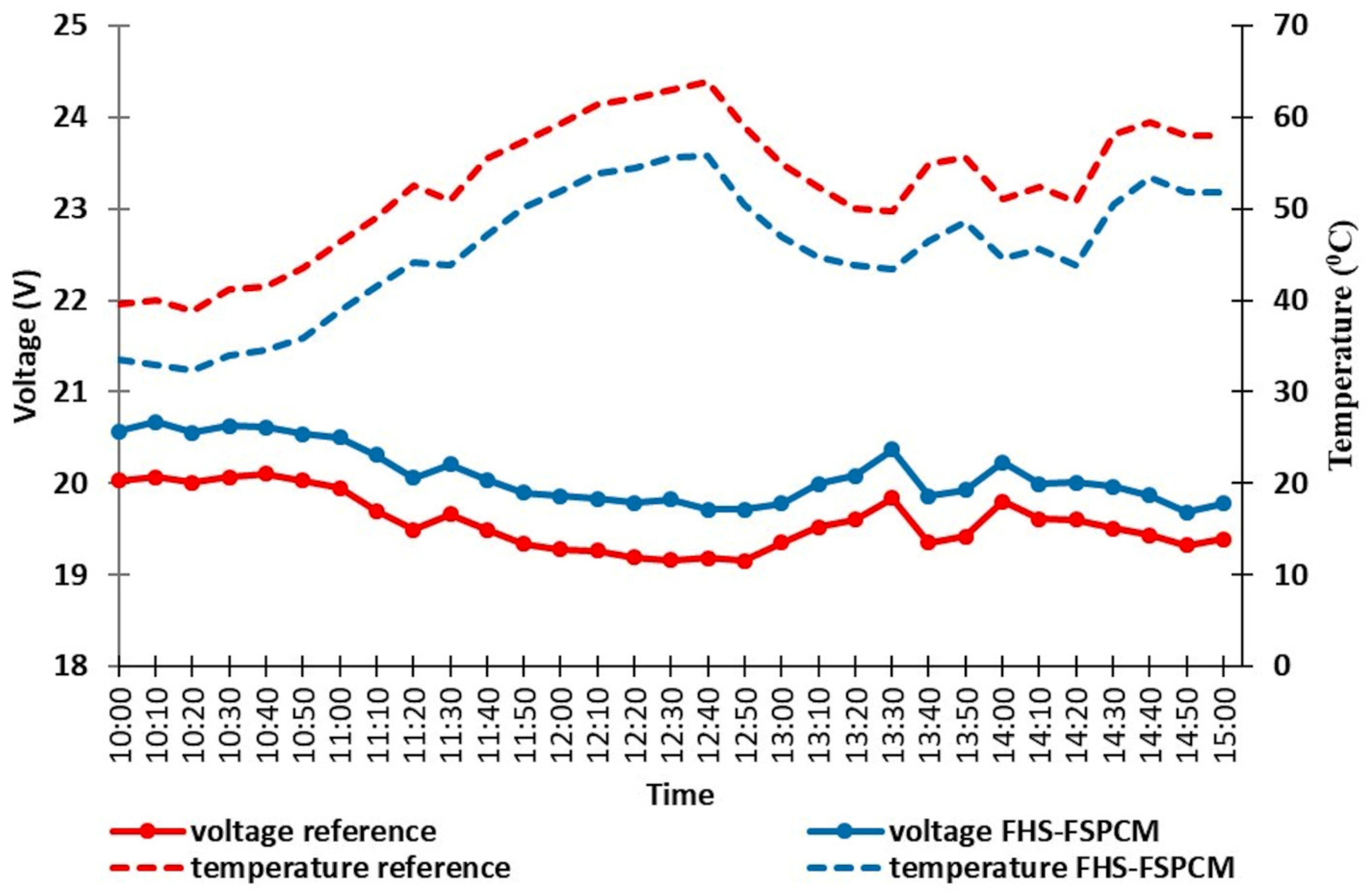

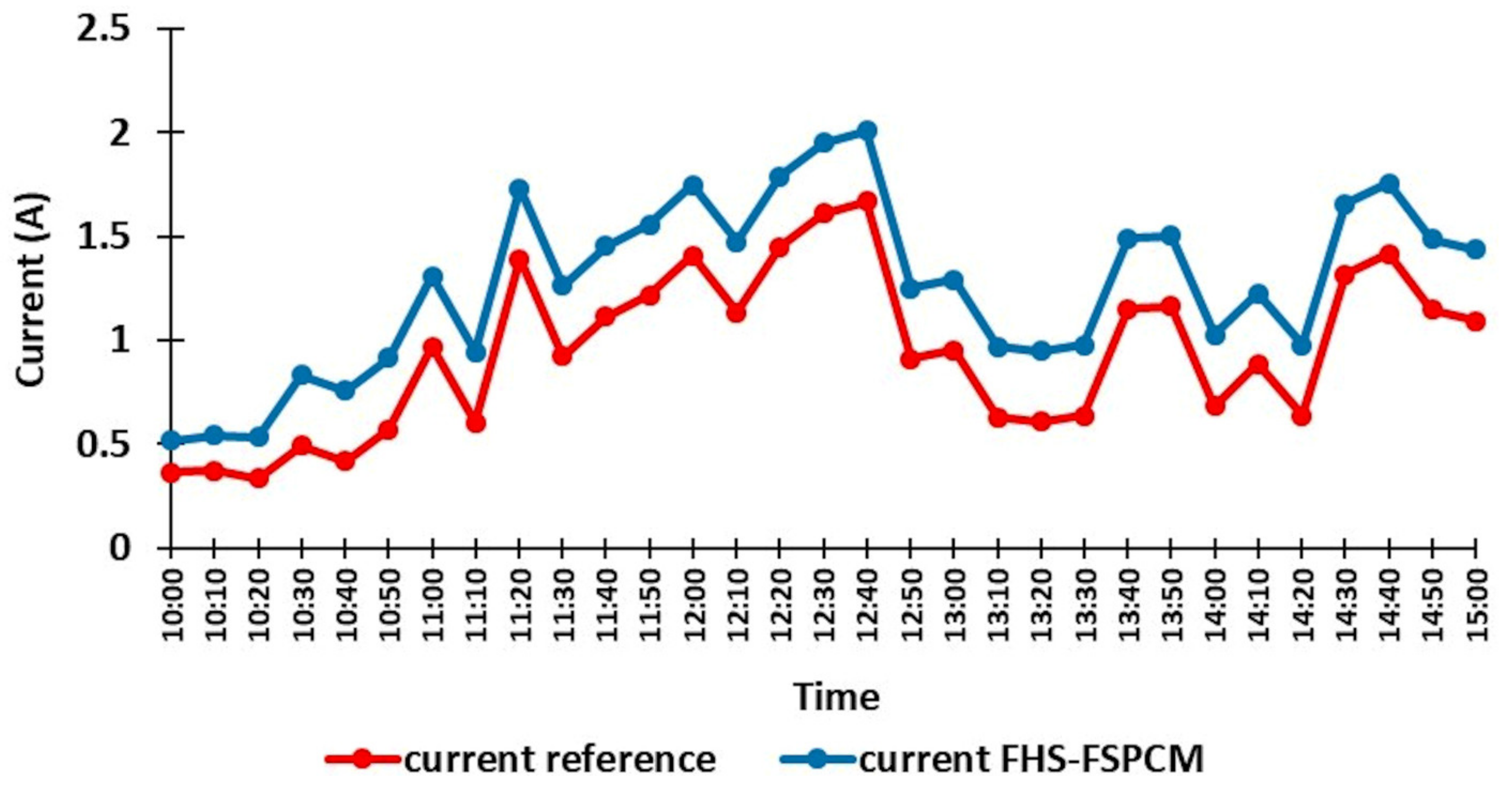
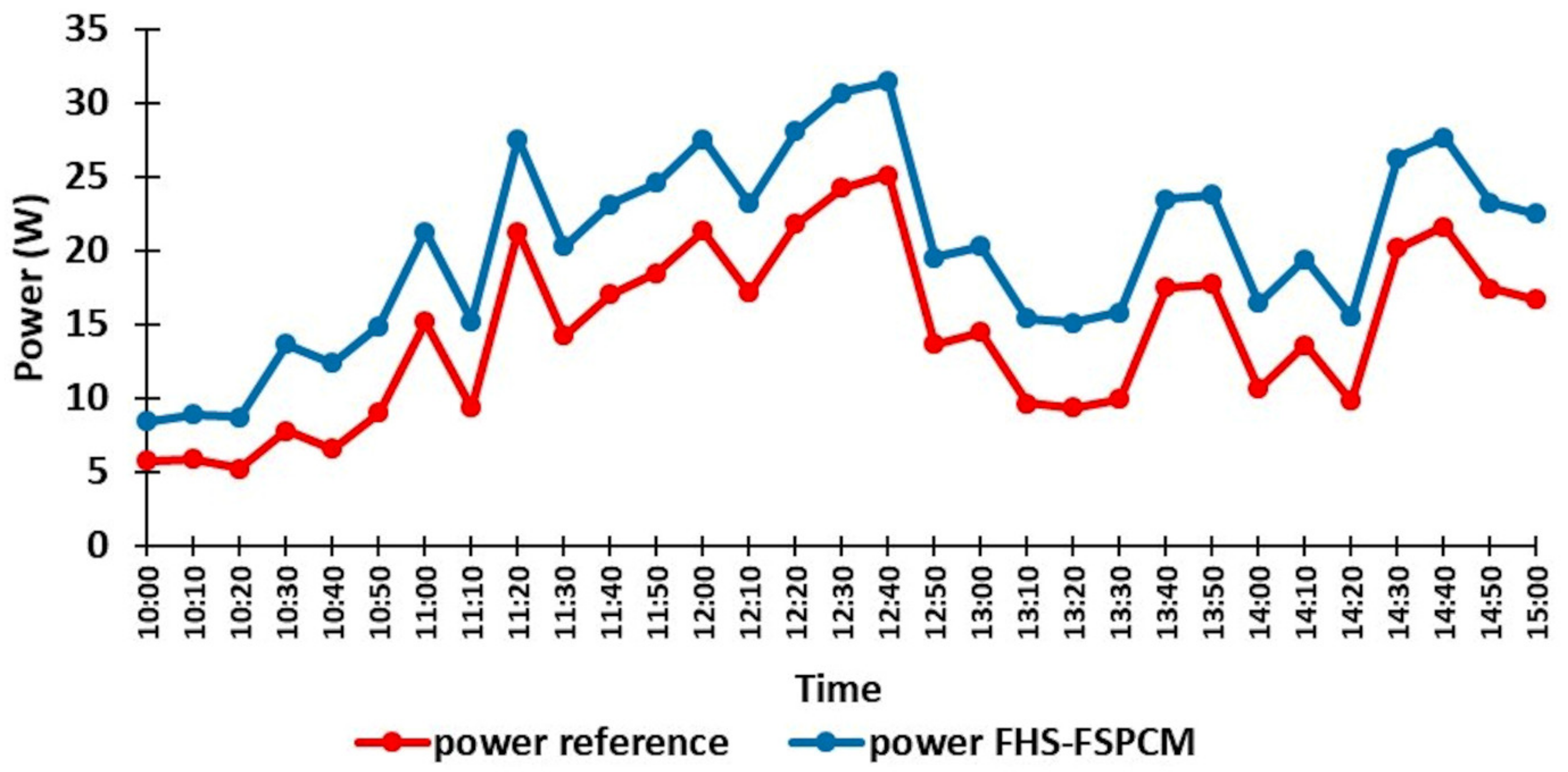
| Material | Specific Heat (kJ/kgK) | Latent Heat of Melting (J/g) | Melting Point (°C) | Latent Heat of Freezing (J/g) | Freezing Point (°C) |
|---|---|---|---|---|---|
| FSPCM | 3.01 | 130.30 ± 1.29 | 54.60 ± 0.08 | 129.95 ± 1.21 | 50.51 ± 0.08 |
| Aluminum | 0.88 | 399.90 | 660.3 | - | - |
| Polyurethane foam insulator | 1.50 | - | - | - | - |
| Parameter | Value |
|---|---|
| Maximum power | 39.25 W |
| Maximum current | 2.05 A |
| Maximum voltage | 19.15 V |
| Short circuit current | 2.18 A |
| Open circuit voltage | 22.89 V |
| Fill factor | 0.79 |
| Heat Sink | Power (W) | Temperature of Thermocouples (°C) | |||||||||||
|---|---|---|---|---|---|---|---|---|---|---|---|---|---|
| T1 | T2 | T3 | Ths | T4 | T5 | T6 | Tfs | T7 | T8 | T9 | Tfin | ||
| FHS | 10 | 38.7 | 38.6 | 38.3 | 38.5 | 38.3 | 38.2 | 38.2 | 38.2 | 38.2 | 38.1 | 38.1 | 38.1 |
| 20 | 53.6 | 53.4 | 53.5 | 53.5 | 53.0 | 52.9 | 53.0 | 53.0 | 52.9 | 52.9 | 52.8 | 52.9 | |
| 30 | 69.0 | 68.5 | 68.7 | 68.7 | 67.9 | 68.0 | 67.9 | 68.0 | 67.9 | 67.7 | 67.7 | 67.8 | |
| FHS-FSPCM | 10 | 34.2 | 34.4 | 33.8 | 34.1 | 29.8 | 29.7 | 29.7 | 29.7 | 29.7 | 29.7 | 29.6 | 29.7 |
| 20 | 49.5 | 49.2 | 49.0 | 49.2 | 44.4 | 44.4 | 44.3 | 44.4 | 44.2 | 44.3 | 44.2 | 44.2 | |
| 30 | 61.3 | 61.0 | 60.8 | 61.0 | 56.4 | 56.4 | 56.3 | 56.4 | 56.2 | 56.3 | 56.2 | 56.3 | |
| Power | Temperature of Thermocouples (°C) | Difference Percentage (%) | |||
|---|---|---|---|---|---|
| Taverage | Without FSPCM | With FSPCM | Difference | ||
| 10 W | Ths | 38.5 | 34.1 | 4.4 | 11.43 |
| Tf | 38.2 | 29.7 | 8.5 | 22.25 | |
| Tfin | 38.1 | 29.7 | 8.4 | 22.05 | |
| 20 W | Ths | 53.5 | 49.2 | 4.3 | 8.04 |
| Tf | 53.0 | 44.4 | 8.6 | 16.23 | |
| Tfin | 52.9 | 44.2 | 8.5 | 16.07 | |
| 30 W | Ths | 68.7 | 61.0 | 7.7 | 11.21 |
| Tf | 68.0 | 56.4 | 11.6 | 17.06 | |
| Tfin | 67.8 | 56.3 | 11.5 | 16.96 | |
| No. | FSPCM (PCM/Supporting Material) | FSPCM Properties | PV Cooling | Reference | ||||
|---|---|---|---|---|---|---|---|---|
| Melting Point (°C) | Latent Heat of Melting (J/g) | Freezing Point (°C) | Latent Heat of Freezing (J/g) | Reduction of PV Panel’s Temperature (°C) | Increment of Maximum Power Output Generation (%) | |||
| 1. | Myristic acid/cross-linked nitrile rubber | 54.60 ± 0.08 | 130.30 ± 1.29 | 50.51 ± 0.08 | 129.95 ± 1.21 | 7.2 | 39.45 | Current study |
| 2. | Polyethylene glycol/expanded graphite | 34.7 | 125.97 | - | - | 4-6 | - | 25 |
| 3. | Sugarcane wax-Al2O3 composite/gelatin-gum Arabic | 62 | 68.09 | 60.83 | 53.77 | 3.87 | 7 | 26 |
Publisher’s Note: MDPI stays neutral with regard to jurisdictional claims in published maps and institutional affiliations. |
© 2021 by the authors. Licensee MDPI, Basel, Switzerland. This article is an open access article distributed under the terms and conditions of the Creative Commons Attribution (CC BY) license (https://creativecommons.org/licenses/by/4.0/).
Share and Cite
Munusamy, Y.; Lin Onn, J.W.; Alquraish, M.; Kchaou, M.; Sethupathi, S. Thermal Performance of Finned Heat Sinks Embedded with Form-Stable Myristic Acid Phase Change Material in Photovoltaic Cooling for Green Energy Storage. Energies 2021, 14, 6860. https://doi.org/10.3390/en14216860
Munusamy Y, Lin Onn JW, Alquraish M, Kchaou M, Sethupathi S. Thermal Performance of Finned Heat Sinks Embedded with Form-Stable Myristic Acid Phase Change Material in Photovoltaic Cooling for Green Energy Storage. Energies. 2021; 14(21):6860. https://doi.org/10.3390/en14216860
Chicago/Turabian StyleMunusamy, Yamuna, John Wong Lin Onn, Mohammed Alquraish, Mohamed Kchaou, and Sumathi Sethupathi. 2021. "Thermal Performance of Finned Heat Sinks Embedded with Form-Stable Myristic Acid Phase Change Material in Photovoltaic Cooling for Green Energy Storage" Energies 14, no. 21: 6860. https://doi.org/10.3390/en14216860
APA StyleMunusamy, Y., Lin Onn, J. W., Alquraish, M., Kchaou, M., & Sethupathi, S. (2021). Thermal Performance of Finned Heat Sinks Embedded with Form-Stable Myristic Acid Phase Change Material in Photovoltaic Cooling for Green Energy Storage. Energies, 14(21), 6860. https://doi.org/10.3390/en14216860







